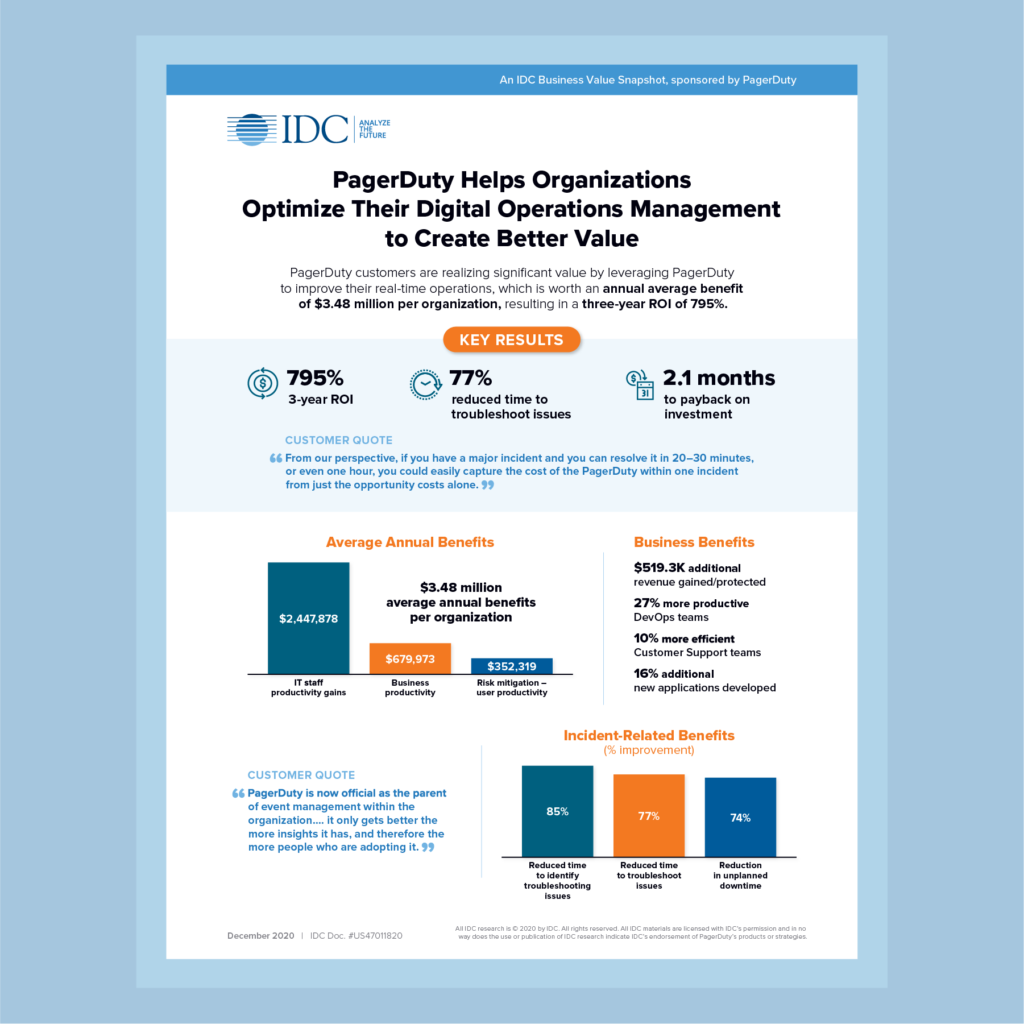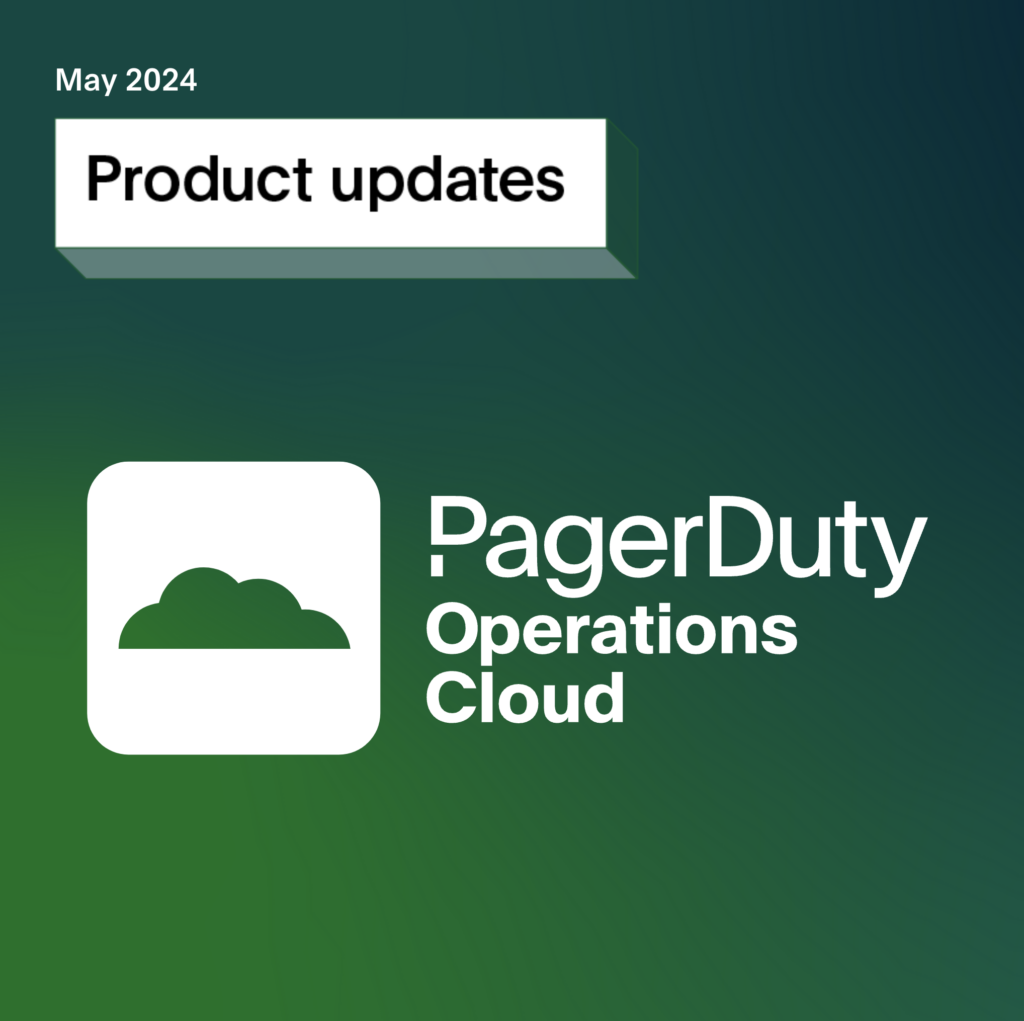- PagerDuty /
- Blog /
- Digital Operations /
- New IDC Study Highlights PagerDuty’s Multi-Million Dollar ROI
Blog
New IDC Study Highlights PagerDuty’s Multi-Million Dollar ROI
Dependence on digital business skyrocketed in the last year, with customers expecting seamless, always-on access to applications and digital services from any device, anywhere. This trend has placed developer and IT teams under more pressure than ever before to not only deliver these digital experiences, but keep them up and running at all times.
Digital acceleration drives wider adoption of newer technologies like cloud and microservices, which enable the agility and cost structure required by digital business; however, it also presents technical organizations with a double-edged sword. These new, digital services are now absolutely critical to business success, but they introduce new operational challenges in order to manage them successfully. It requires a new approach to digital operations management so that an organization’s teams can successfully own services in production—despite the new levels of complexity. Service ownership empowers teams to identify, triage, mobilize, and take action on business-critical incidents in order to maintain the customer experience.
A Platform to Drive Digital Acceleration
Therefore, organizations looking to accelerate their digital transformation journey need a digital operations management platform that can enable the cultural shift to full-service ownership. A platform that allows organizations to:
- Use machine learning to group alerts and accelerate the acknowledgment and prioritization of incidents
- Automatically route incidents to the right people and teams at the right time
- Enable real-time incident response tailored for operations teams and business owners to improve coordination and impact assessment and offer the ability to automate response tasks
- Provide intelligent postmortem assessment to learn, benchmark, improve, and automate operational response
- Integrate with their unique ecosystem of observation, monitoring, customer support, security, and service management tools
PagerDuty provides this breadth of capabilities. The benefits from using a vendor platform that does this can be huge. These benefits include:
- Improved staff productivity and work-life balance
- Increased business productivity
- Additional time for workers to innovate and create new value
- Better revenue protection and customer experience from unplanned downtime
At PagerDuty, we always look to quantify the true business value that organizations can gain from deploying and using our platform. Because of this, we recently commissioned leading global industry analyst firm IDC to interview 14 PagerDuty customers to understand, validate, and quantify the business value that our platform delivers.
On average, these customers have 22,700 employees—1,852 of whom work in IT and are responsible for over 190 business applications. These organizations were interviewed about the impact of PagerDuty on the business, their IT team, incident management, and costs.
The Business Benefits Are Clear
Overall, the IDC study showed that PagerDuty customers are gaining an average annual benefit of $3.48 million per organization, resulting in a three-year ROI of 795%, and a payback period of 2.1 months when deploying and using PagerDuty to optimize digital operations.

The PagerDuty platform helps customers improve across the incident response lifecycle by increasing efficiency, alignment, and productivity across disparate teams. IDC reports the value of this to be $2,447,878 per organization.
Customers also use PagerDuty to integrate incident management across business teams such as customer services, enabling them to deliver a better experience for users and customers. IDC calculates the value of this at $679,973 per organization.
In addition, our customers have reduced the frequency and risk of outages and downtime using PagerDuty, meaning higher employee productivity and less revenue loss. IDC quantified the value of this at $352,319 per organization.
Incident-Related Benefits Driving ROI
The IDC analysis shows these annual savings are being driven by improvements in the time it takes to identify and troubleshoot incidents, with customers reporting a 74% reduction in unplanned downtime.
These time savings and productivity gains allow teams to focus on driving innovation. For DevOps, PagerDuty is helping teams to focus on developing new applications and features instead of firefighting. Overall, DevOps teams that use PagerDuty are 27% more productive, allowing them to develop 16% more new applications—without having to add staff or outsource development.
Customer Support teams are 10% more efficient because they can leverage information shared from PagerDuty in real time on digital incidents. This helps frontline customer service agents proactively manage issues with customers and deliver a better experience.
Organizations also reported that PagerDuty is allowing IT infrastructure management teams to spend more time on higher-value projects instead of firefighting, with teams reporting an efficiency improvement of 18%.
Rapid ROI Provides Fast Value
Overall, it is clear that PagerDuty customers achieve substantial benefits from the platform, with significant annual savings, productivity improvements, and an ROI that allows them to recoup their investment in just over 2 months. As one customer interviewed for the study noted:
“From our perspective, if you have a major incident and you can resolve it in 20–30 minutes, or even one hour, you could easily capture the cost of PagerDuty within one incident—from just the opportunity costs alone.”
The True Value of PagerDuty
IDC found that PagerDuty’s digital operations management platform empowers organizations to:
- Increase the efficiency and productivity of IT teams across the incident response life cycle.
- Significantly reduce the time required to identify, troubleshoot, and resolve issues.
- Create a culture of autonomy and full-service ownership, which improves efficiencies in DevOps, IT, customer service, and security teams.
- Reduce the effects of unplanned downtime on business users and customers.
For a full review of IDC’s research results and analysis, including customer insights, check out the full report.


